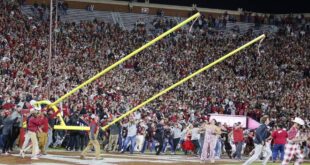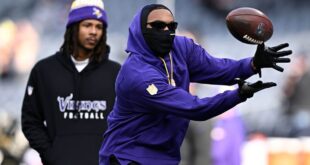New England Patriots center David Andrews came back to the sideline after a drive a few years ago, content with the job he’d just done blocking for quarterback Tom Brady.
Unbeknownst to Andrews, though, an image captured by cameras and shown on the sideline tablets given to NFL teams told a different story.
Legendary offensive line coach Dante Scarnecchia came over screaming. Even though Andrews thought he blocked his man just fine, the picture showed him out of place, and Scarnecchia wasn’t interested in debate. He let Andrews hear it.
The next day, during a film review with the offensive line, video of the play revealed that Andrews had actually properly blocked his guy. Scarnecchia, a man prone to impassioned scoldings, said he was sorry for the outburst.
“That felt good when he apologized,” Andrews said. “So the pictures are great, but they don’t tell the whole story.”
Coaches and players have lots of stories like that. Sometimes the pictures taken for review on the sideline are captured at precisely the wrong moment, and someone gets chewed out when they didn’t do anything wrong.
But now, the NFL is nearing an inflection point on a debate nearly a decade in the making that could completely change how teams make in-game adjustments. The question is a simple one that’s likely to gain traction this offseason when rule changes are considered: to use or not to use all-22 video on the sideline instead of just photos? The league’s competition committee has twice broached the subject, in 2016 and 2018, and tabled the conversation both times amid a generation of coaches that wasn’t receptive to the change.
Now, though, with a wave of younger coaches taking on head jobs, there seems to be more of an appetite for the switch, and the league has quietly offered teams trial periods. Both last year and this year, the NFL greenlit all-22 video access on the sideline for a week of preseason games, allowing coaches to get familiar with the technology as they contemplate whether or not they’d be in favor of a switch, and for the league to explore new ways to test its video systems.
It sets up a fascinating debate about technology usage and where advantages may lie.
The last two times the debate was encountered, the most influential and experienced coaches largely pushed back on the idea of changing to video access on the sideline. Their argument was essentially that there should be a reward for the coaches smart enough to correctly identify what the other team is doing in real-time or via pictures, and that offering sideline video access to everyone would dumb down the product and level the playing field for coaches not as skilled.
On the flip side, many members of this younger generation of coaches now climbing the ranks argue sideline video would instead place a premium on the best coaches. If sideline video helps you know exactly what the other team is doing and how they’re going to defend a certain play, the smartest, most adaptable coaches would make in-game adjustments from the sideline. Thus, they argue, video doesn’t level the playing field — it actually rewards the team with better coaches able to more quickly teach a new plan to their team.
“To me, it would only further the chess match even more,” said T.J. Yates, 37, the quarterbacks coach of the Atlanta Falcons who spent seven years as an NFL quarterback. “That’s one of the things coaches love most about the game and the job. Your entire week of prepping is a chess match. You’re anticipating what they’re going to do and vice versa. With video, it’s just an in-game version of that. So I see it as nothing but good things — but I’m a younger coach, I get that.”
It’s oversimplifying the matter to say younger coaches are in favor of the change and older ones aren’t. Six years ago, Sean McVay was against the change, and he said through a Rams spokesperson that he remains against video on the sideline. It’s also worth noting that McVay, the league’s third-youngest coach at 38, is a member of the 10-person competition committee that considers rule changes. But the most vocal coaches against a change six years ago were Bruce Arians, Mike McCarthy and Mike Zimmer.
“If I’m looking at the video, I’ll never be wrong,” Zimmer, the former head coach of the Minnesota Vikings, said in 2018. “I’m against it because I think it takes some of your true coaching skills away and it makes it even for everybody, for good coaches and bad coaches.”
Now, some coaches’ tunes might be changing.
“It would be great if we had video on the sideline,” said Seattle Seahawks coach Mike Macdonald, the league’s youngest coach at 37. “Why would you not want the video on the sideline?”
The league’s second-youngest coach, Jerod Mayo of the Patriots, is also in favor of the change.
“If everyone has video, I don’t know what the problem would be,” he said.
In 2013, Microsoft signed a five-year, $400 million deal with the NFL to become the sole provider of sideline tablets, ensuring all teams used Microsoft Surface devices (Microsoft has since re-upped that partnership at an undisclosed price). Before that, teams had a printer on the sideline that printed pages of images, and it was the job of an assistant to put all the pages into a binder for coaches and players to use.
Teams get 20 league-provided tablets per sideline and 12 in each coach’s booth during games. The tablets receive 12 images per play, which are transmitted nearly in real time, the league said. The pictures are captured at various points during each play and usually include both pre- and post-snap shots.
But the technology for video replay on the sideline has existed for years. The league let teams try it during a preseason game in 2016 after its first debate on the subject. And the technology has spread far beyond just the NFL.
Many coaches have a similar tale of first encountering it on a recent trip to a high school game. For Macdonald, it was when he went to recruit a player while working for the University of Michigan in 2021. When he showed up to the high school game, he couldn’t believe there was a big-screen TV on the sideline allowing coaches to instantly rewatch plays, something that has become commonplace at major programs, even at that level.
“I thought that was pretty cool,” Macdonald said.
College football made rule changes this year to embrace similar technology. They allowed coaches to use microphones to communicate into the helmet of a player to share play calls, and, for the first time, they allowed video review of previous plays on sideline tablets. That’s why we went to Bill O’Brien, a former NFL head coach now at Boston College, making him the rare NFL coach using video technology every weekend.
“I think it helps the play of the game,” O’Brien said. “It helps the rhythm of the game, the players have a better understanding of how to play and there’s less sloppy play. I really believe that.”
Added Yates: “So high school is doing the video, college is doing the video and we’re the only ones stubborn enough not to do it.”
While the NFL has yet to embrace the technology for games, it is being used more widely around the league during practices.
When Jon Gruden was the Las Vegas Raiders’ coach, he installed an on-field TV for practices that could quickly review the previous drill or play. McVay took that idea to the Los Angeles Rams, and it spread from there. At least six teams (the Rams, Falcons, Vikings, Browns, Packers and Seahawks) use the technology at practices.
A cool new addition to Vikings practices’ is this massive outdoor TV. It shows the all-22 view of the most recent drill/play on loop and lets coaches and players study in real time. The Rams do it — that’s where Kevin O’Connell got the idea. pic.twitter.com/KJUjwTIdT0
— Chad Graff (@ChadGraff) May 17, 2022
Coaches explained that it allows them to review a teaching point with a player and fix the issue seconds before another rep. It also allows them to fix a play on the fly, a departure from the days of having to watch video after practice, make the correction during a meeting, then attempt the modified play at the following day’s practice.
“We obviously always go back and look at the tape,” McVay said during training camp. “But if there is something that maybe we didn’t see, it really provides a good opportunity to get that thing corrected right away.”
At first, wide receiver K.J. Osborn admitted, it was a weird addition to the practice field when coach Kevin O’Connell brought it to the Vikings. He joked that it looked like a movie night.
“But after we started using it, I realized it was really helpful and now I think every team should have that,” Osborn said.
The exact rule change proposals for the league’s competition committee to consider this offseason won’t be set for a few months. But with the spread of on-field video in high school, college and NFL practices — and after allowing video review during a preseason game — it seems the league could be headed for another debate on whether or not to embrace the technology.
“I think it could only help grow the game,” Yates said, “and, hey, maybe it gives the guys on ‘First Take’ something to talk about.”

Free, daily NFL updates direct to your inbox.
Free, daily NFL updates direct to your inbox.
— Michael-Shawn Dugar of The Athletic contributed to this story.
(Top illustration: Kelsea Petersen / The Athletic; photos: Ric Tapia, Bobby Levey, Rich Schultz, Justin Tafoya and Nick Cammett / Getty Images)
 meganwoolsey Home
meganwoolsey Home





